1. 引言
有机氯农药(OCPs)是一类具有“三致”效应的持久性有机污染物,其中六六六(HCH)和滴滴涕(DDT)是其中使用最为广泛的品种,在土壤环境中普遍存在,严重危害农产品安全和人体健康[1] -[3] 。近年来,土壤的修复方法得到了迅速发展,其中植物修复技术以及其环境友好、价格低廉等优点越来越受到重视[4] 。植物吸收主要通过植物吸收一种或几种污染物,并将所吸收的污染物进行转移、贮存在体内,从而达到修复受污染环境的目的[5] -[8] 。研究表明,植物能从土壤中直接吸收有机氯农药[9] -[12] 。
但由于受到酶活性和数量等的限制,植物本身对有机污染物的降解能力较弱。对此有研究者提出了利用表面活性剂增溶作用强化植物修复技术(SEPR) [13] -[15] ,然而单一表面活性剂在土壤中易发生吸附及沉淀损失从而降低了对有机污染物的增溶洗脱效率[16] 。而使用阴–非离子混合表面活性剂可降低表面活性剂在土壤中的吸附及沉淀损失,提高对有机污染物的增溶洗脱效率[17] [18] ,并且在一定条件下可以促进有机污染物的微生物降解[19] 。朱利中等[20] 研究了阴–非混合表面活性剂对菲等多环芳烃(PAHs)的增溶作用,发现混合表面活性剂对PAHs的增溶大于单一表面活性剂的增溶,且具有协同增溶作用。周文军等[21] 研究了阴–非离子混合表面活性剂对菲污染土壤的洗脱作用及机理,发现阴–非离子混合表面活性剂可显著提高对有机污染土壤的洗脱效率,在表面活性剂增效修复技术中具有良好的应用前景。周溶冰等[22] 研究了混合表面活性剂对水培植物吸收有机氯农药的影响,发现加入表面活性剂后,黑麦草根中p,p'-DDT的含量最高达到无表面活性剂对照组的70倍。但迄今关于阴–非混合表面活性剂对植物吸收土壤中OCPs的影响的研究较为缺乏。
本文选取HCH和DDT为有机氯农药代表,其中HCH包含4种常见异构体(α-HCH、γ-HCH、β-HCH、δ-HCH),DDT也包含4种常见异构体(p,p'-DDE、o,p'-DDT、p,p'-DDD及p,p'-DDT),总共8种有机氯农药异构体,采用土培体系模拟研究阴–非离子混合表面活性剂SDBS-TX100、SDBS-TW80对植物吸收OCPs的影响,试图为建立经济、高效的OCPs污染土壤SEPR-植物联合修复技术提供依据。
2. 材料与方法
2.1. 材料
非离子表面活性剂 Triton X-100、Tween-80 (TX100,纯度 > 98%),阴离子表面活性剂十二烷基苯磺酸钠(SDBS,纯度 > 98%)购自Tokyo Kasei Kogyo Co. Ltd.。α-HCH、γ-HCH、β-HCH、δ-HCH、p,p'-DDE、o,p'-DDT、p,p'-DDD及p,p'-DDT购自Chem Service(纯度 > 99.5%)。将SDBS和TX100溶于去离子水中制备一系列不同配比(SDBS与TX100质量比分别为0:10,1:9,5:5,9:1)及浓度(50、100、300、700、1000 mg·L−1)的SDBS-TX100混合溶液。SDBS和TW80同样配比与浓度制备得SDBS-TW80混合溶液。
2.2. 实验方法
实验土壤采自杭州电子科技大学下沙校区内,土壤类型为滨海盐土,pH为8.30,有机质含量11.9 g/Kg,砂粒、粉砂粒和粘粒含量分别为3.93%、86.6%和9.50%。将已知浓度的HCHs,DDTs丙酮溶液与相应重量的土壤混合均匀配制为高浓度污染土,并将浸泡后的土样置于通风橱内7 d,至丙酮完全挥发。然后按所需取相应量的高浓度污染土与盆栽土壤混合均匀,装盆待用。
设计为期100 d的盆栽试验,每盆土壤500 g,土壤中各农药质量分数均为0.25 mg/kg。2011年3月于温室内播种紫花苜蓿,每盆9株,3个重复,于生长期间分别施加不同配比与浓度的SDBS-TX100、SDBS-TW80混合溶液800 mL。实验期间调节并保持土壤含水量为田间持水量的50 %。
另设置对照组,种植紫花苜蓿于上述污染土壤中,照管方法同上,但不施加表面活性剂。
2.3. 样品处理及测定
2.3.1. 植物样品处理
将植物样品充分剪碎,称取适量置于50 mL离心管中,加入30 mL正己烷与丙酮混合液(1:1,V:V)超声萃取1 h。将萃取液过装有2 g无水Na2SO4的层析柱,收集于50 mL圆底烧瓶中,在50℃下旋转蒸发至干。用2 mL正己烷润洗,取1 mL装有2.5 g硅胶的层析柱净化,再用10 mL二氯甲烷与正己烷混合液(1:1,V:V)淋洗,收集于50 mL圆底烧瓶中。再次旋转蒸发至干,用1 mL正己烷定容,最后进GC-ECD分析,每个样品重复2~3次。
2.3.2. 土壤样品处理
称取鲜土样品1 g,放入离心管中,并加入2 g无水硫酸钠并另去少量鲜土放入烘箱中105℃,7 h,测定含水率。向离心管中加入20 mL丙酮:二氯甲烷(1:1)混合液,超声萃取30 min。在4000 r/min的条件下离心15 min,取上清液。重复上述萃取、离心过程,合并提取液。用旋转蒸发仪将上清液浓缩至1~2 mL,再用2 g活化后的佛罗里硅土纯化,同时用10 mL丙酮:正己烷(1:9)混合液淋洗。再次过2 g无水硫酸钠柱,用10 mL丙酮:正己烷(1:9)淋洗。用旋转蒸发仪蒸发至干。用1 mL色谱纯正己烷定容,最后取1 μL进样。
2.3.3. 样品测定
OCP分析使用气相色谱(福立GC-9790,浙江温岭),配备有63Ni-ECD检测器和毛细管柱DB-5 (30 m × 0.32 mm × 0.25 μm),柱温180℃,进样器和检测器的温度分别为280℃和290℃,进样量1 μL;进样器和检测器的温度分别为220℃和300℃,经过分子筛和氧阱的高纯氮气作载气和尾吹气,流速分别为2.25和35.5 mL·min−1,1 μL样品进样不分流,DDTs 和HCHs的检测限分别为0.20~0.50 ng·g−1,回收率实验共做了3次,平均回收率分别为83%~87% [22] 。
3. 结果与讨论
3.1. SDBS-TX100、SDBS-TW80对紫花苜蓿生长影响
经100 d培养,不同SDBS-TX100、SDBS-TW80浓度与配比下紫花苜蓿生物量如图1所示。SDBSTX100浓度为50 mg·L−1、100 mg·L−1时,平均每株生物量为0.59~1.40 g;SDBS-TX100浓度为300 mg·L−1、700 mg·L−1时,平均每株生物量为0.5~0.8 g;浓度为1000 mg·L−1时,平均每株生物量为0~0.5 g。与不施加表面活性剂的对照:紫花苜蓿平均每株生物量为0.73 g相比,SDBS-TX100浓度为50 mg·L−1、100 mg·L−1对紫花苜蓿生长有促进作用;浓度为1000 mg·L−1时生物量小于0.7 g,配比9:1时植株死亡,显然浓度1 000 mg·L−1对植物生长有抑制作用。同浓度相比,配比为0:10及9:1时对紫花苜蓿生长促进作用小于配比1:9及5:5。
SDBS-TW80在浓度为50、100、300 mg·L−1时,平均每株紫花苜蓿生物量为0.5~0.92 g,此三组浓度中随着SDBS增加、TW80减少生物量先增后减,最高值出现在9:1及5:5上。浓度在700、1000 mg·L−1时,随着SDBS增加、TW80减少生物量逐渐减少,9:1时生物量为零。可见,配比9:1的高浓度SDBS-TX100对紫花苜蓿生长有严重毒害作用,致使植物枯萎(见图1)。
3.2. SDBS-TX100对紫花苜蓿根部吸收OCPs的影响
采用2.3节的处理与测定方法,取得植物的根部与茎叶进行分析,测出不同部位对OCPs的吸收量(以干重计)。当SDBS-TX100配比为1:9时,紫花苜蓿根部对OCPs的吸收量在混合表面活性剂浓度为1 000 mg·L−1时达到最大,约为100 mg·kg−1;在浓度为300 mg·L−1时也达到较大的值,约为80 mg·kg−1。与未加表面活性剂时相比较:紫花苜蓿根部OCPs浓度为16.6 mg·kg−1),紫花苜蓿根部对OCPs的吸收效率分别提高了6倍,表明阴–非离子混合表面活性剂对紫花苜蓿吸收OCPs有显著影响。
当SDBS-TX100配比为9:1时,紫花苜蓿根部对OCPs的吸收量在混合表面活性剂浓度为50 mg·L−1时达到最大,约为80 mg·kg−1。与未加表面活性剂时相比较,紫花苜蓿根部对OCPs的吸收效率分别提高了4.4倍,表明阴–非离子混合表面活性剂对紫花苜蓿吸收OCPs有显著影响。
SDBS-TX100配比为0:10及5:5时,随浓度增加紫花苜蓿根部OCPs先增后减,低浓度TX100促进根部吸收OCPs,高浓度TX100抑制根部吸收。配比为1:9时,随浓度紫花苜蓿根部吸收能力基本呈现上升趋势,与配比0:10相比,SDBS与TX100共同作用不仅提高相同SDBS-TX100浓度下根部吸收OCPs能力,也在一定范围内改变了高浓度TX100会抑制紫花苜蓿根部吸收OCPs;除浓度为50 mg·L−1时OCPs最高值出现在配比9:1,其余四个浓度OCPs最高均出现在配比为1:9。可见,配比1:9时,阴–非离子表面活性剂的促进作用最优(见图2)。
3.3. SDBS-TW80对紫花苜蓿根部吸收OCPs的影响
当SDBS-TW80配比为0:10时,紫花苜蓿根部对OCPs的吸收量在混合表面活性剂浓度为50 mg·L−1时达到最大,约为62 mg·kg−1,与未加表面活性剂时相比较,紫花苜蓿根部对OCPs的吸收效率分别提高了3.2倍,表明阴–非离子混合表面活性剂对紫花苜蓿吸收OCPs有显著影响。
当SDBS-TW80配比为1:9时,紫花苜蓿根部对OCPs的吸收量也在混合表面活性剂浓度为50 mg·L−1时达到最大,约为55 mg·kg−1。与未加表面活性剂时相比较,紫花苜蓿根部对OCPs的吸收效率分别提高了2.7倍,表明阴–非离子混合表面活性剂对紫花苜蓿吸收OCPs有较显著影响。
综合图3四种配比,低浓度(50~300 mg·L−1)SDBS-TW80会促进紫花苜蓿根部吸收OCPs,高浓度则抑制其吸收行为。特别为SDBS抑制作用明显。

Figure 1. Biomass of alfalfa in the presence of different concentration & proportion of SDBS-TX100、SDBS-TW80
图1. 不同SDBS-TX100、SDBS-TW80浓度与配比下紫花苜蓿生物量
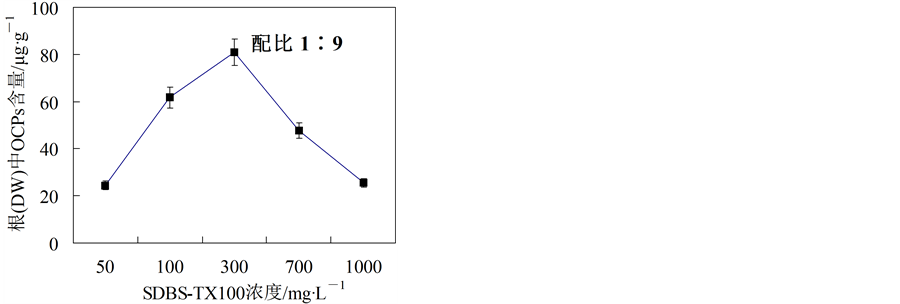
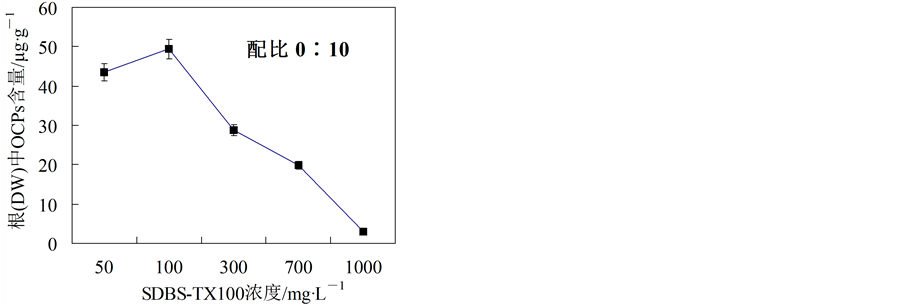
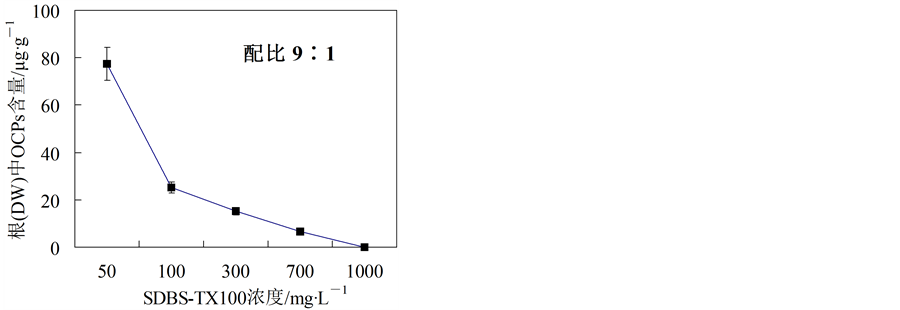
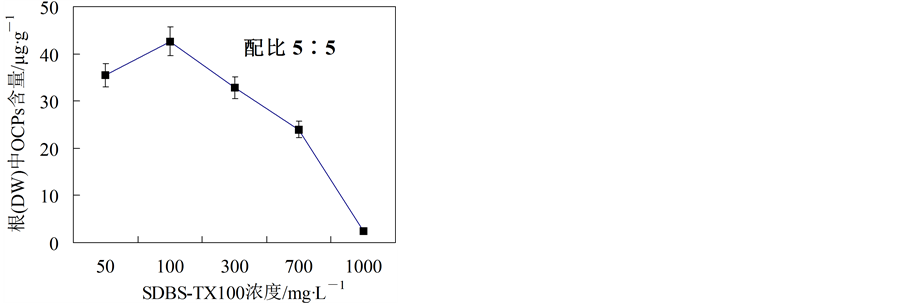
Figure 2. Effects of SDBS-TX100 on alfalfa’s root uptaking of OCPs
图2. SDBS-TX100对紫花苜蓿根部吸收OCPs的影响
3.4. SDBS-TX100、SDBS-TW80对紫花苜蓿茎叶吸收OCPs的影响
对植物茎叶进行处理分析得出数据图4。当SDBS-TX100配比分别为5:5时,吸收量在混合表面活性剂浓度为50 mg·L−1时达到最大,约为82 mg·kg−1,与未加表面活性剂时相比较,紫花苜蓿茎叶吸收提
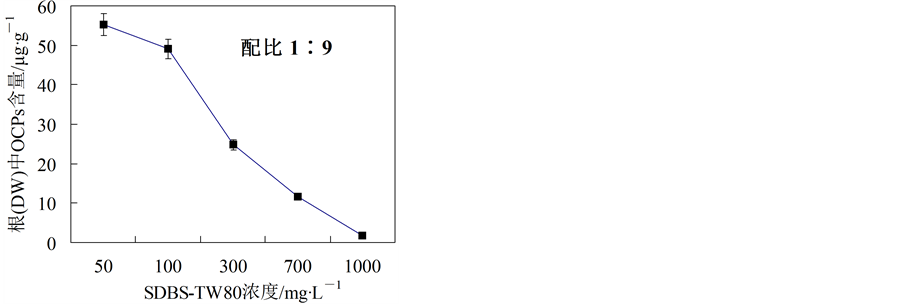
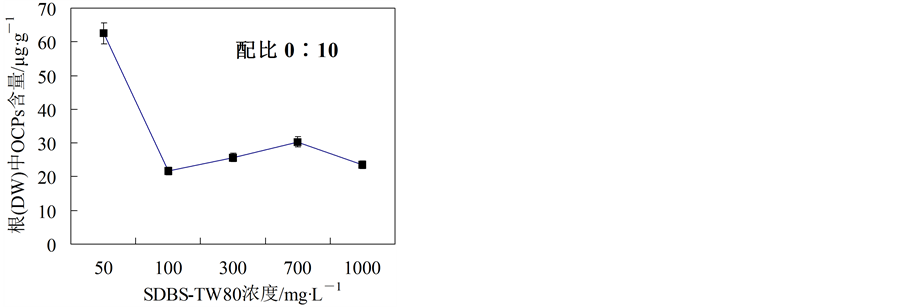
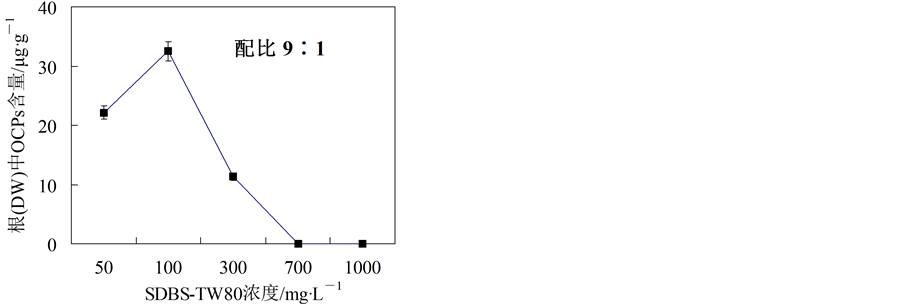

Figure 3. Effects of SDBS-TW80 on alfalfa’s root uptaking of OCPs
图3. SDBS-TW80对紫花苜蓿根部OCPs的影响
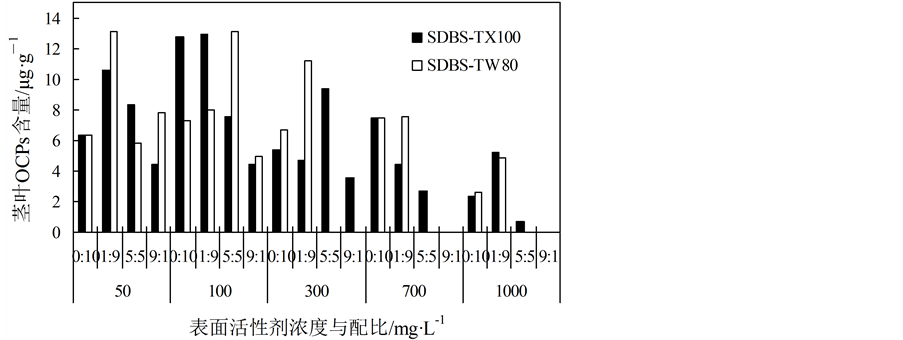
Figure 4. Effects of alfalfa’s shoots uptaking of OCPs in the presence of different concentration & proportion of SDBS-TX100, SDBS-TW80
图4. 不同配比与浓度SDBS-TX100、SDBS-TW80对紫花苜蓿茎叶吸收OCPs 的影响
高了11倍。此两种配比中紫花苜蓿茎叶OCPs含量随SDBS-TX100浓度增加而减少。配比为1:9时,茎叶OCPs浓度呈现先增后减趋势,且均高于未加表面活性剂时的水平,在浓度为100 mg·L−1时达到最大,为12.9 mg·kg−1,约为未加表面活性剂时的1.9倍。
当SDBS-TX100浓度为100 mg·L−1时,紫花苜蓿茎叶对OCPs的吸收量达到平衡,配比0:10、1:9、5:5均高于未加表面活性剂时茎叶中OCPs浓度。
由图4可得,总体上低浓度的SDBS-TX100促进紫花苜蓿茎叶吸收OCPs,高浓度SDBS-TX100抑制紫花苜蓿茎叶吸收OCPs。且在配比9:1时,紫花苜蓿茎叶吸收能力得到抑制。
当SDBS-TW80配比分别为1:9时,紫花苜蓿茎叶对OCPs的吸收量高于未加表面活性剂时的,浓度为50 mg·L−1时达到最大,约为13 mg·kg−1,是未加表面活性剂时的1.9倍。
当SDBS-TW80配比为5:5时,茎叶OCPs浓度呈现先增后减趋势,且均高于未加表面活性剂时的水平,浓度为100 mg·L−1时达到最大,约为13 mg·kg−1,但在浓度高于700 mg·L−1时表面活性剂明显抑制紫花苜蓿茎叶吸收OCPs。
由图4可得,总体上只有SDBS-TW80配比1:9和5:5在低浓度时促进紫花苜蓿茎叶吸收OCPs,配比0:10和1:9在低浓度时有微小的促进作用。四种配比在高浓度时均抑制了紫花苜蓿茎叶吸收作用。
对比对照组,加入两种系列表面活性剂后紫花苜蓿茎叶内明显富集OCPs,且吸收量受培养液中表面活性剂影响,但茎叶中OCPs含量远远低于根,根部OCPs浓度为茎叶4~7倍。植物修复OCPs污染土壤过程中,土壤中OCPs的消解主要在于植物的根际效应[10] [23] -[26] 。
3.5. SDBS-TX100、SDBS-TW80对土壤OCPs去除率的影响
加入SDBS-TX100的实验组土壤OCPs去除率为51%~68%,且不加表面活性剂种植紫花苜蓿的空白组去除率37%,对比施加SDBS-TX100系列土壤OCPs的去除率明显增加。
加入SDBS-TW80的实验组土壤OCPs去除率为45%~63%,除去300 mg·L−1、9:1最高值,总体上看,SDBS-TW80其作用效果没有SDBS-TX100好,因为紫花苜蓿对SDBS-TW80更为敏感,其对植物的胁迫作用较SDBS-TX100早出现(见图5)。
4. 结论
通过表面活性剂强化植物修复技术促进土壤中的有机氯农药降解是可行的,且不同类型、不同配比与浓度的阴–非离子表面活性剂对植物去除效果存在较大差异。SDBS-TX100对土壤OCPs是去除率保持在50%以上,SDBS-TW80去除率在45%以上,而不加表面活性剂只种植紫花苜蓿的去除率小于37%。
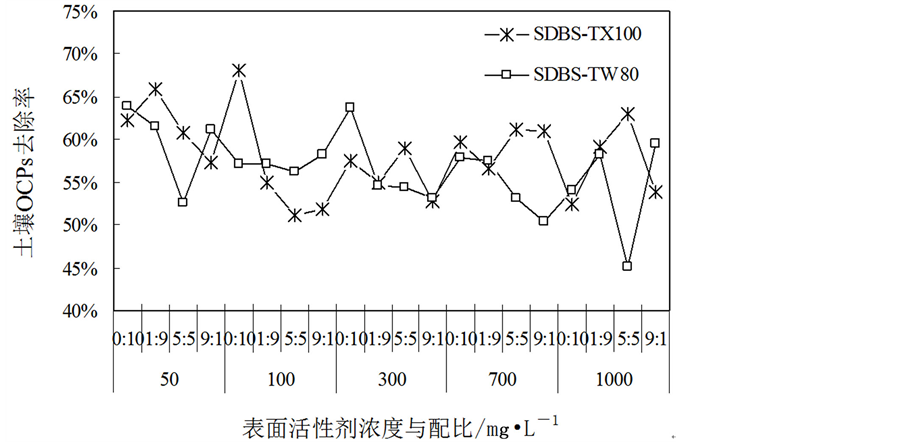
Figure 5. Removal efficiency of OCPs by alfalfa in soil in the presence of different concentration & proportion of SDBS-TX100, SDBS-TW80
图5. 不同配比与浓度SDBS-TX100、SDBS-TW80土壤OCPs的去除率
SDBS-TX100配比为1:9时对紫花苜蓿吸收OCPs有最大促进作用,根部OCPs浓度是未加表面活性剂的4倍,茎叶为1.9倍,且对植物生长无胁迫危害。SDBS-TW80在浓度为50、100、300 mg·L−1时四种配比均促进紫花苜蓿吸收OCPs且无胁迫,但在浓度700、1 000 mg·L−1时配比为5:5、9:1随SDBS浓度增加胁迫危害增大。
综合紫花苜蓿生物量、根部及茎叶OCPs含量及土壤OCPs去除率,施加SDBS-TX100系列效果优于SDBS-TW80。
植物修复OCPs污染土壤过程中,土壤中OCPs的消解主要在于植物的根际效应,根部OCPs浓度为茎叶4~7倍。
基金项目
国家自然科学基金(40801116, 41101213)和浙江省自然科学基金(LY14D01009)。

NOTES
*通讯作者。